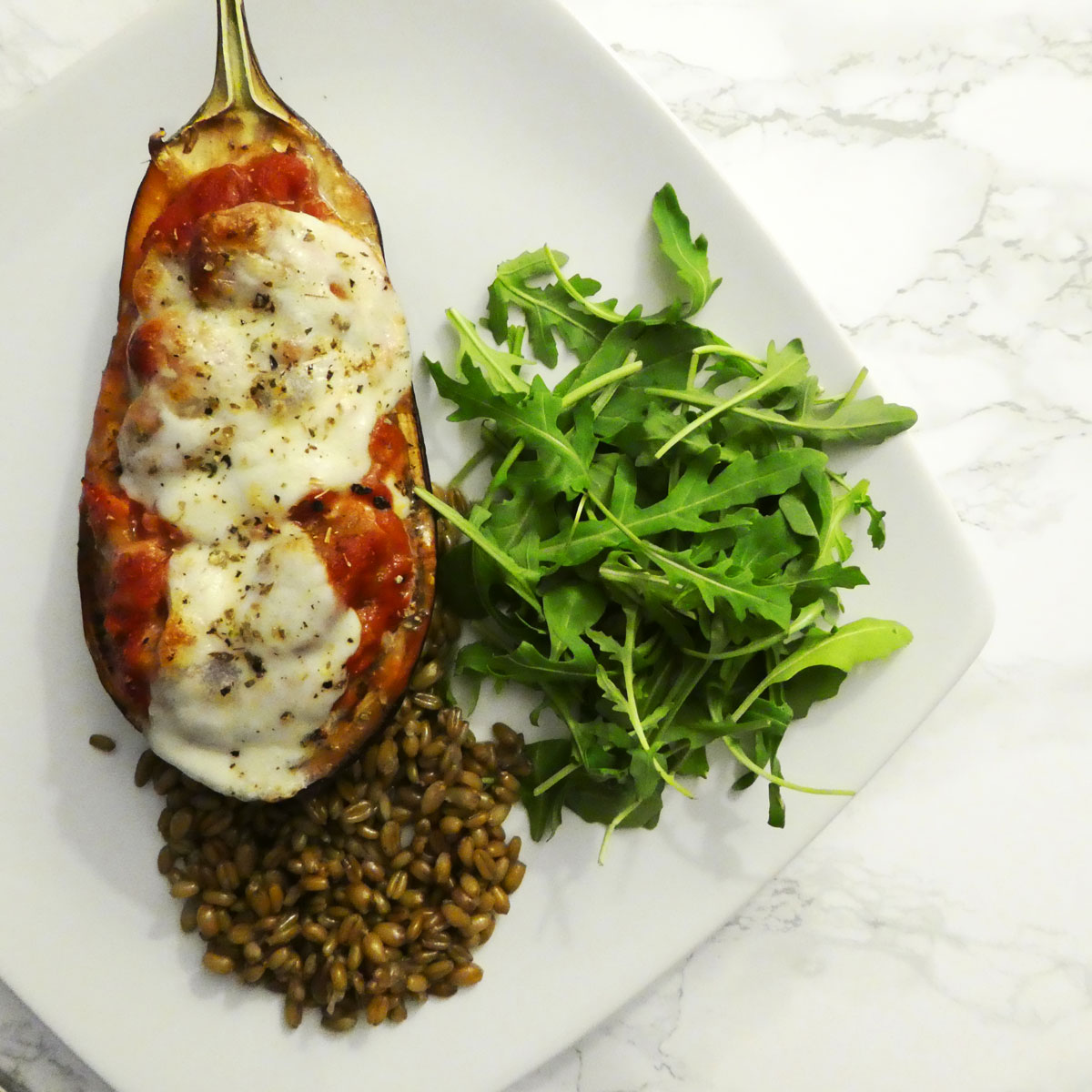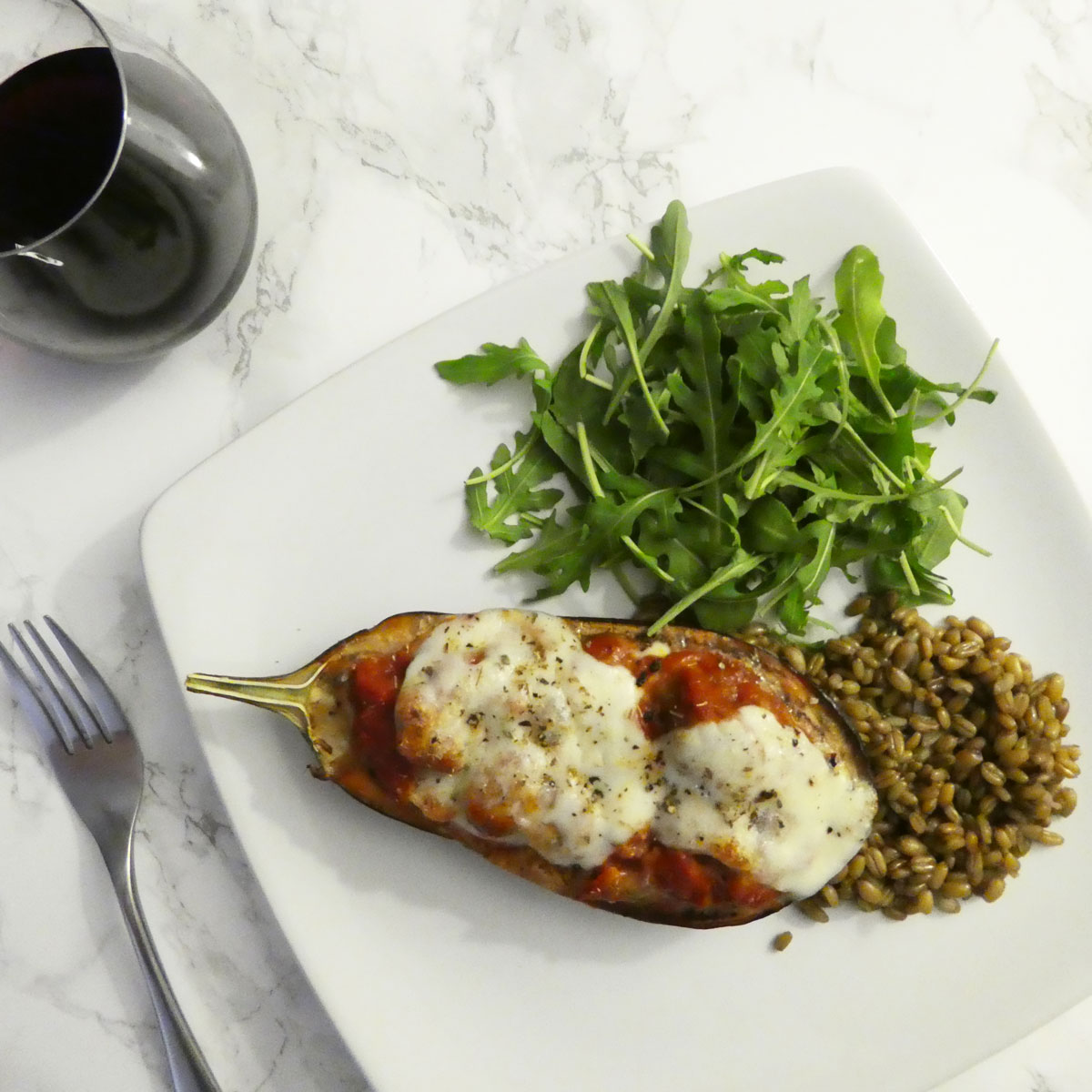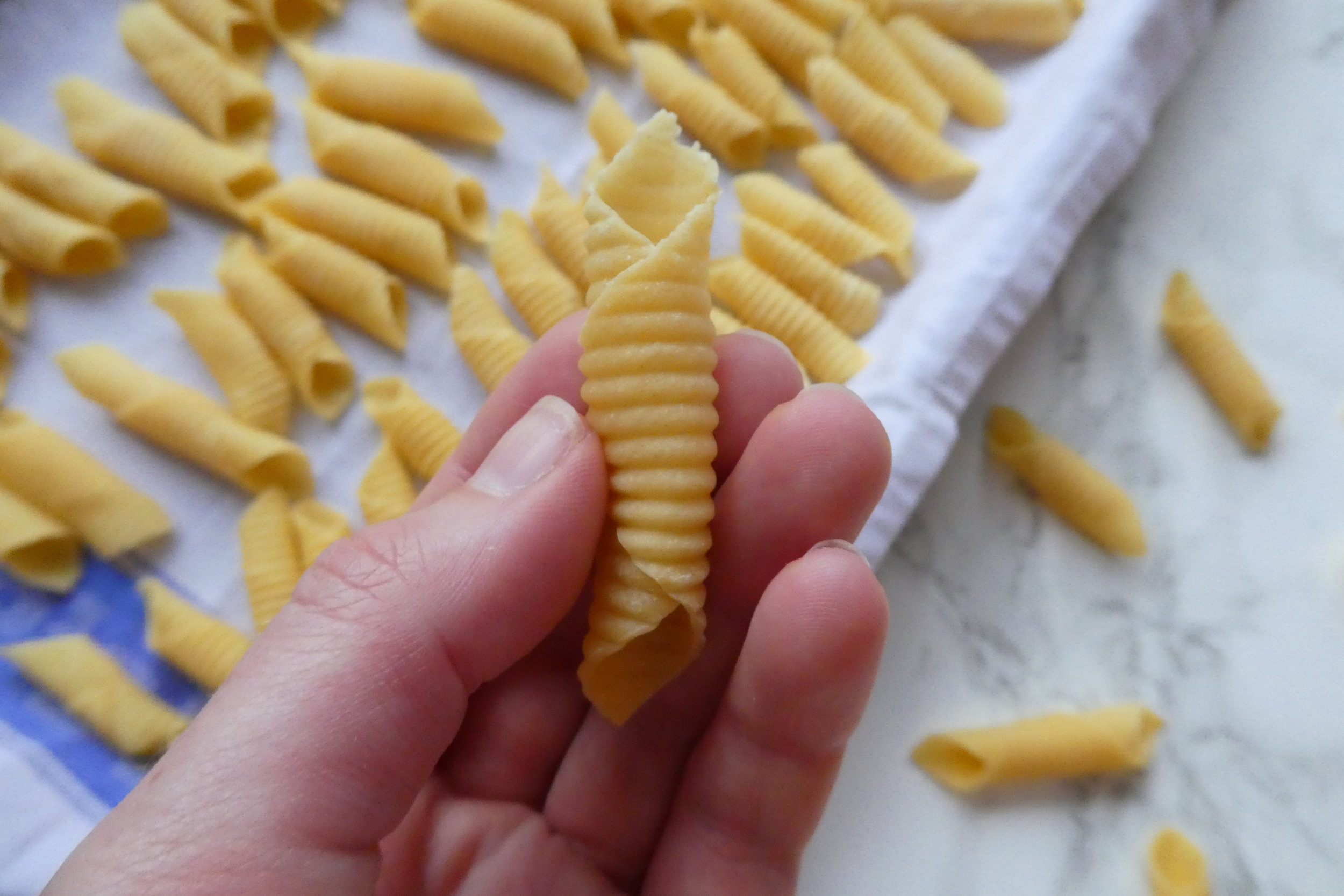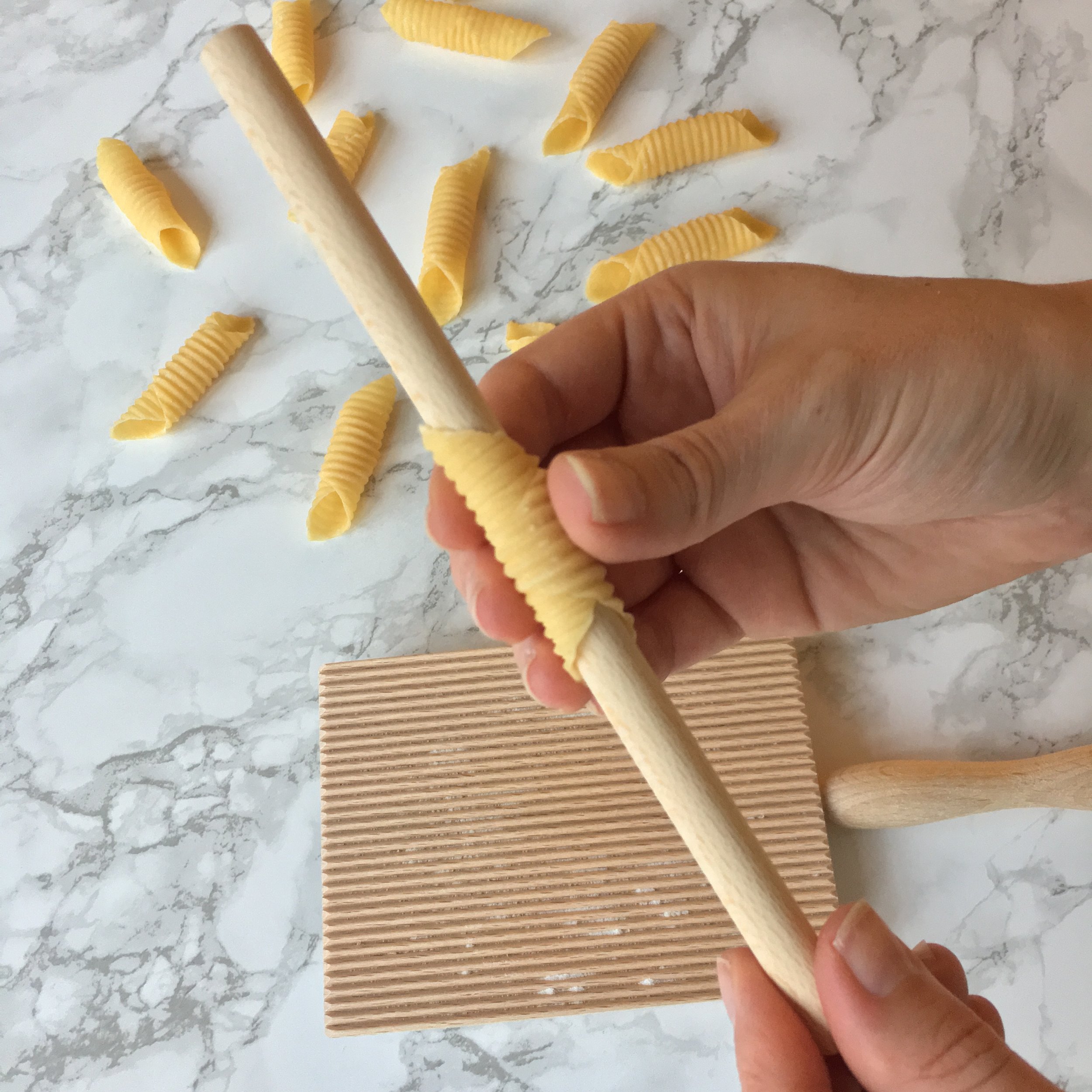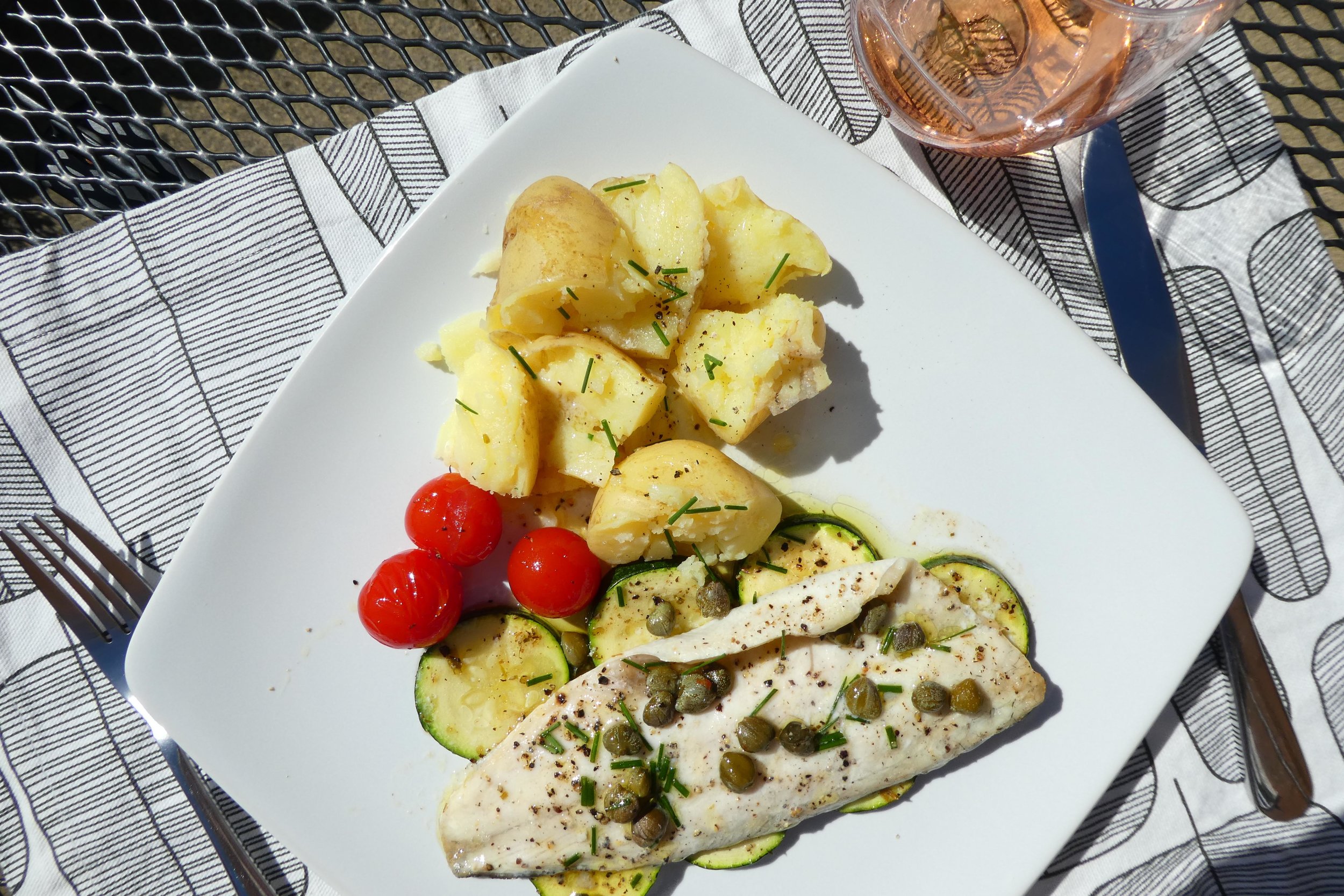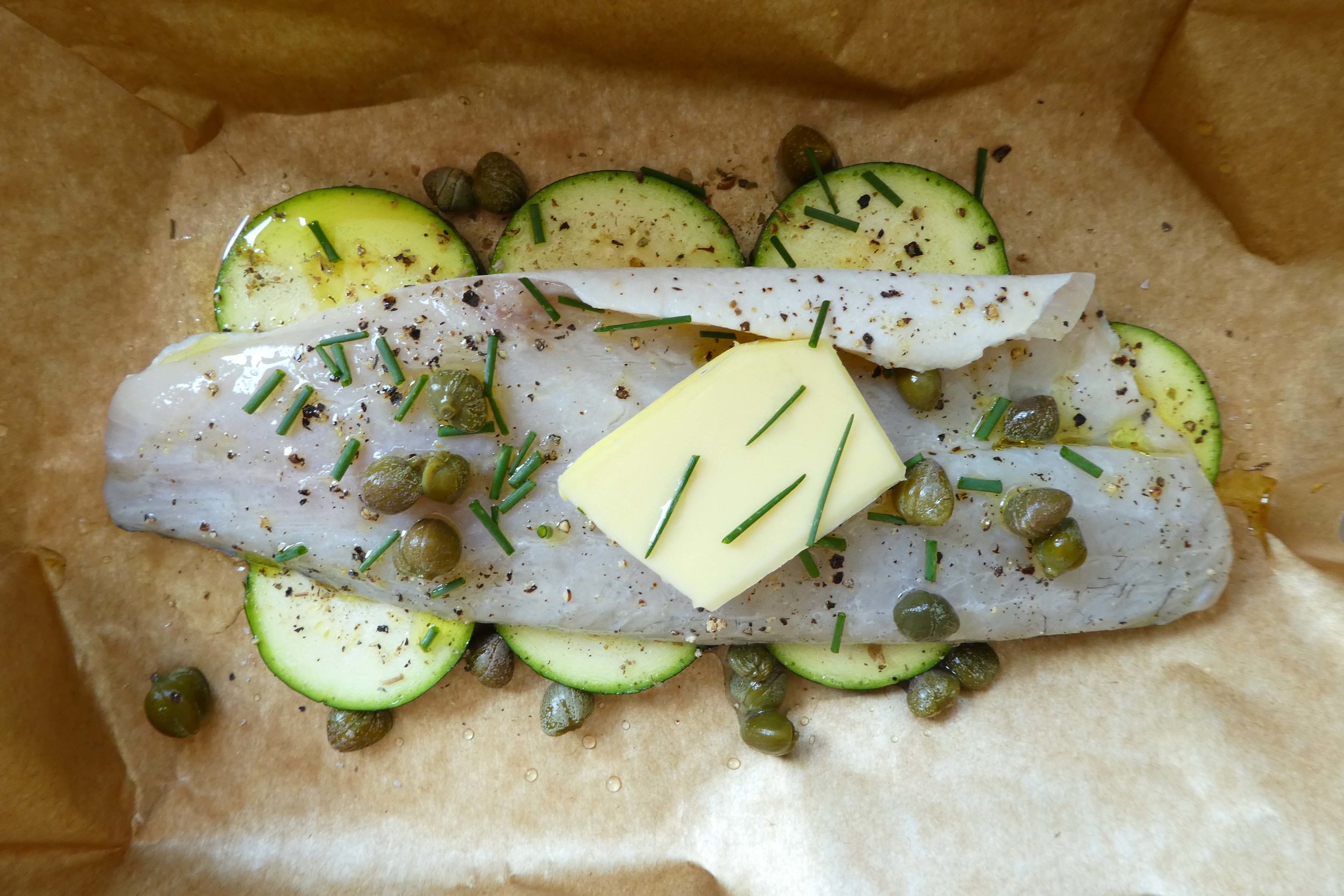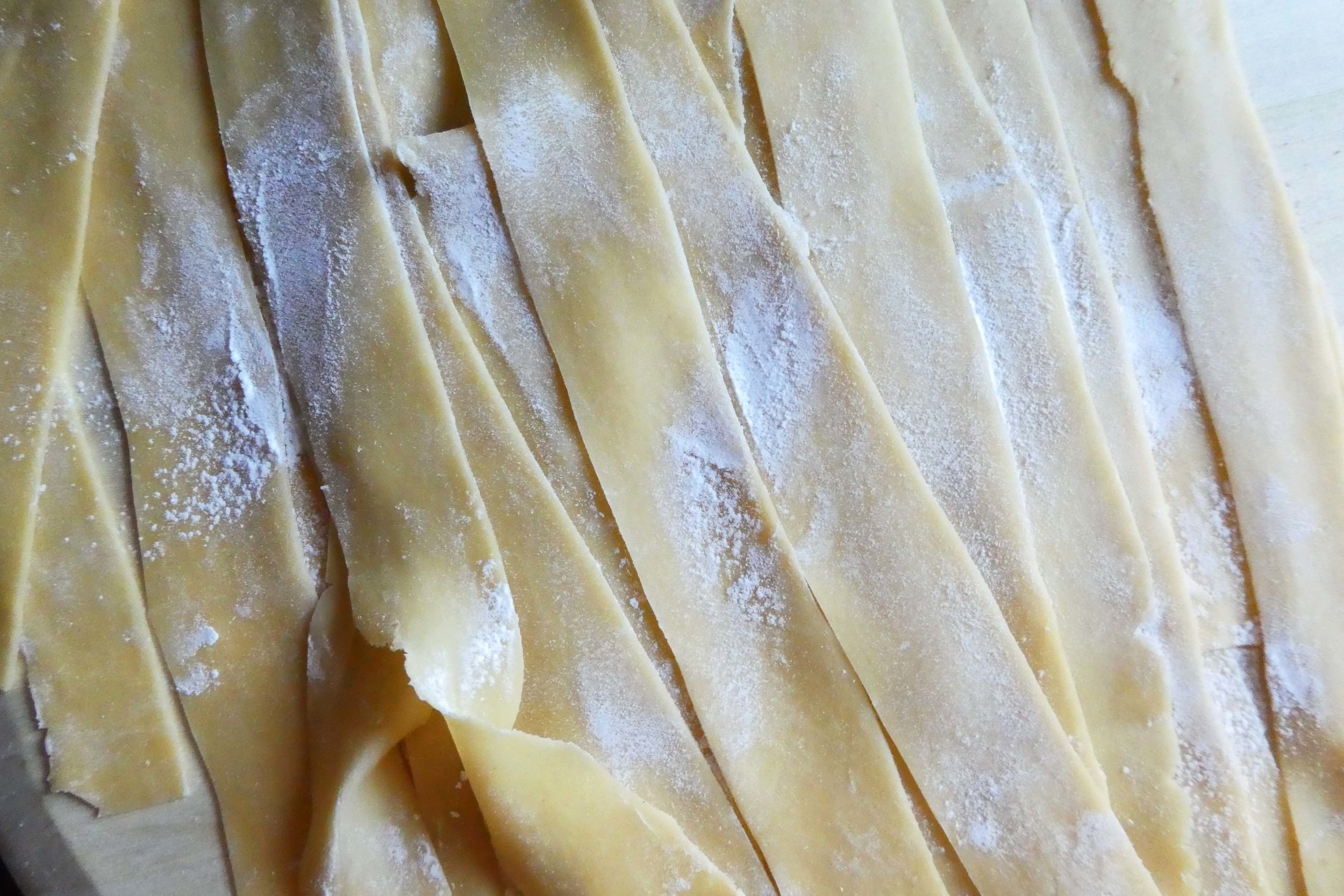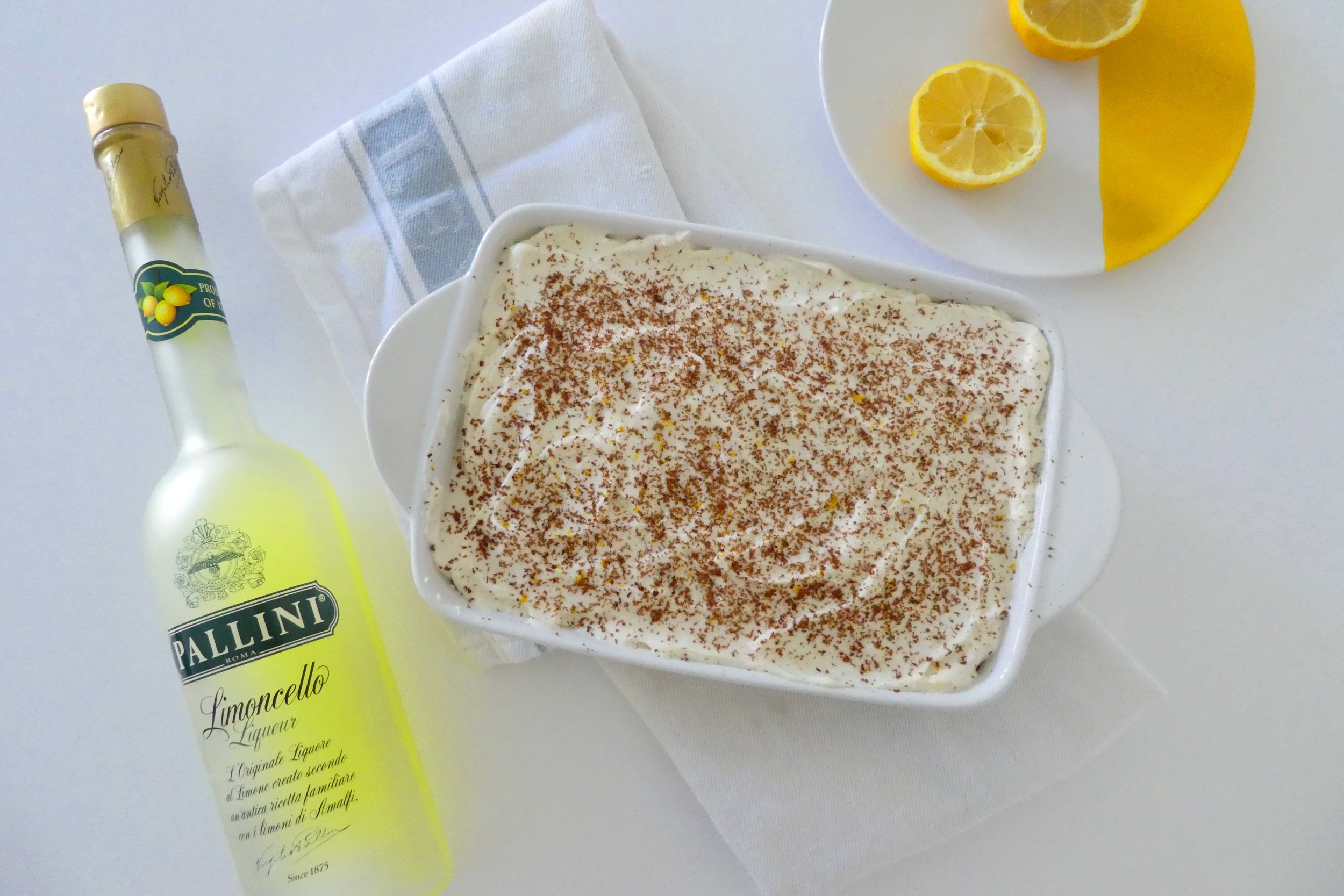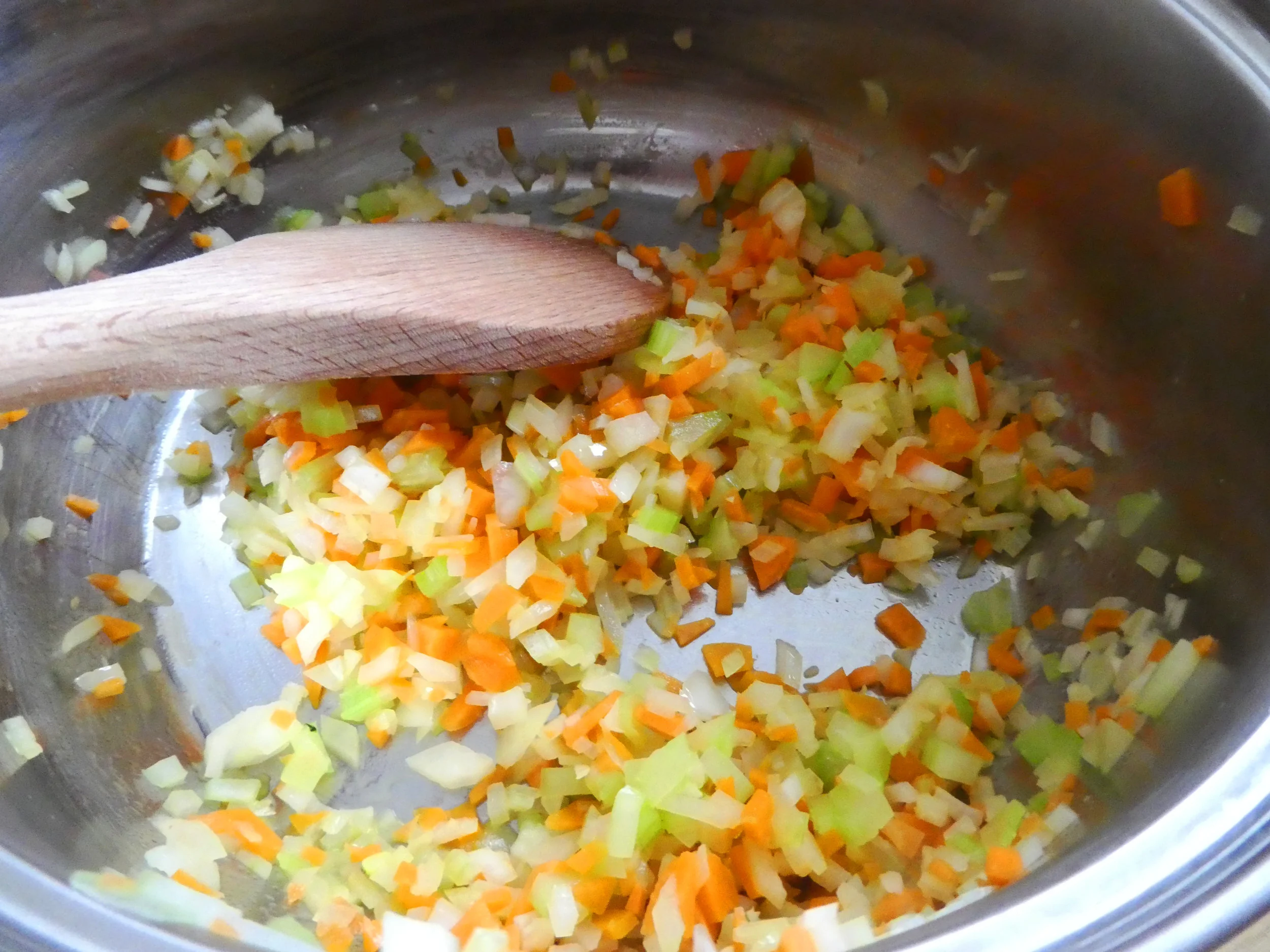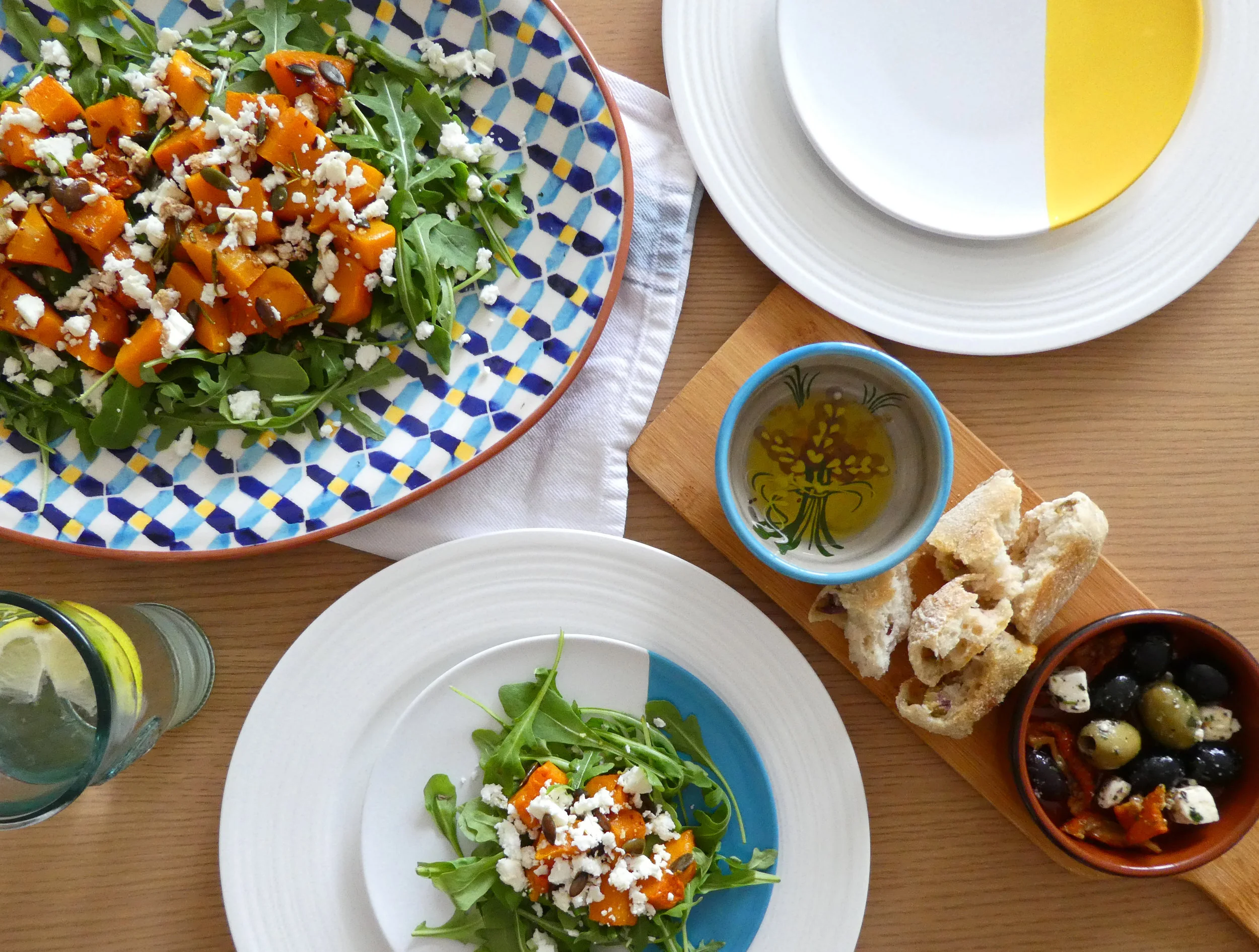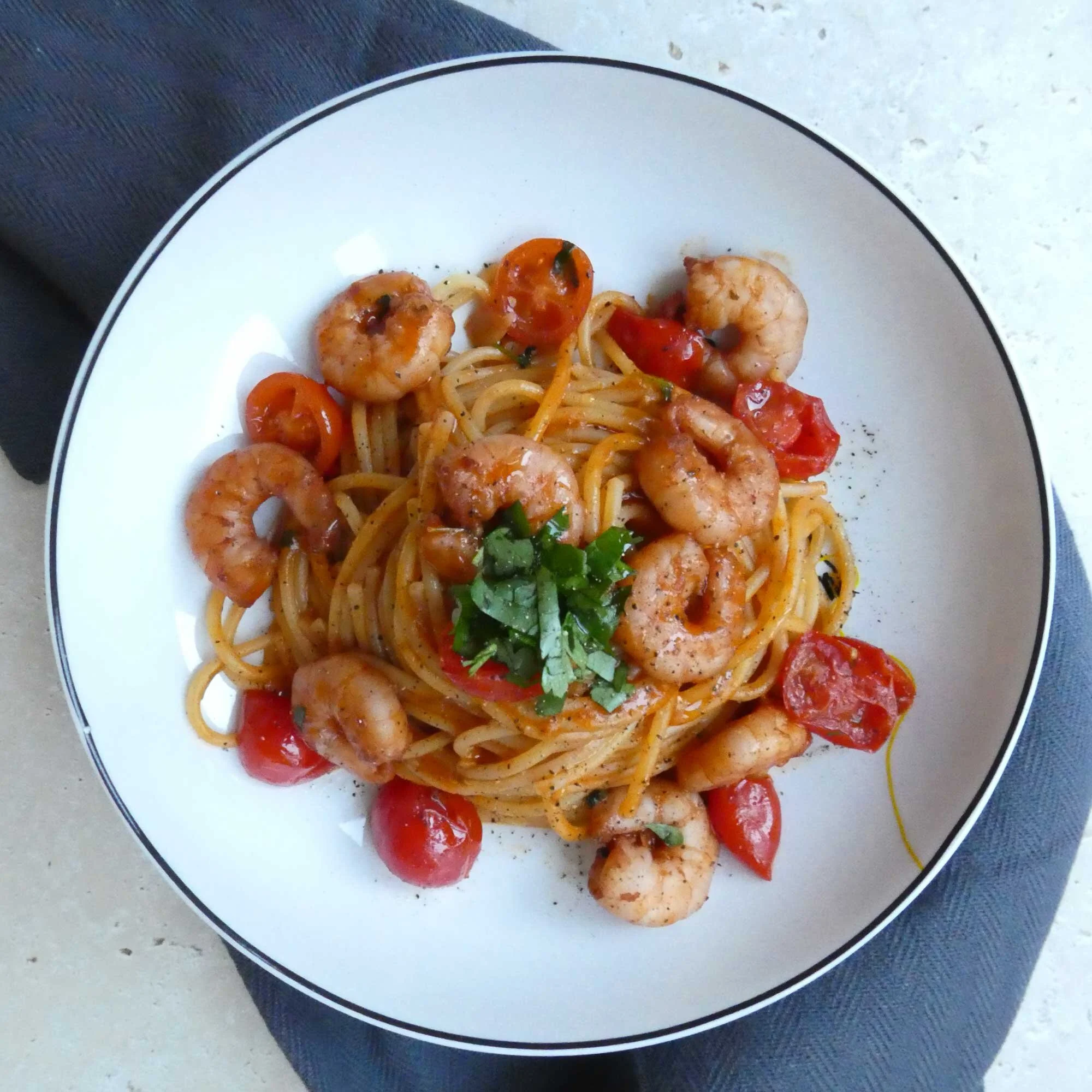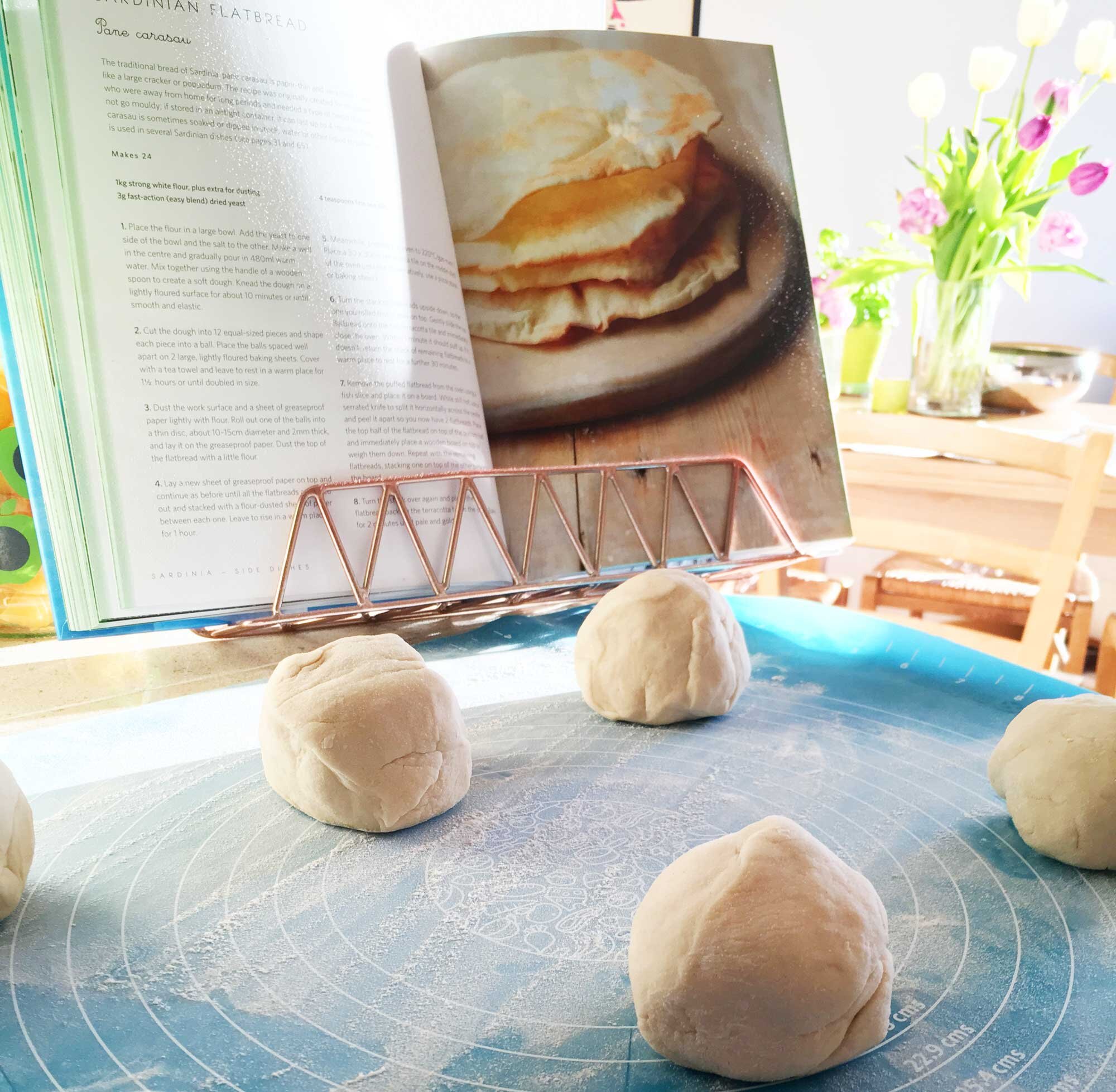Insalata di Tonno
Take a bite of the Mediterranean with this colourful and healthy salad
With the arrival of Spring… sort of, my mind is turning to being healthier, and naturally happier when the sun finally breaks through! I’m on a bit of a health kick anyway at the moment but with warmer days approaching I crave Mediterranean style salads. So here’s one of my favourites, insalata di tonno - I’ve never had a bad tuna salad in Italy, in fact just writing those words have taken me back to sitting in beach bars with this delicious salad served up. This salad is great for work lunches, split out the ingredients and prep ahead for a couple of days or serve it up in a huge bowl great to accompany BBQs.
So here you go, you can mix it up your own way by removing or adding ingredients but this is my perfect combo.
Ingredients:
Mixed salad leaves
Cannellini beans
Tomatoes
Grated carrot
Cucumber
Radishes
Black pitted olives
Extra Virgin Olive Oil & red or white wine vinegar - this for me is the key ingredient, it brings the whole salad alive.
Additional ingredients you could try:
Soft boiled egg (best when its just warm and the yolk is still a little runny)
Asparagus
Mozzarella
What’s your favourite salad combo? Comment below, and share your salad pictures with me on social media tag us on Twitter or Instagram with @CookingCarafes or find me on Facebook.
Insalata di tonno - tuna salad
Spaghetti Carbonara
Follow this simple, 10 minute recipe for perfect Spaghetti Carbonara at home
Is there anything more comforting than a bowl of Spaghetti Carbonara; pasta with cheese and bacon, what’s not to like? This dish is an instant pick me up - it only takes 10 minutes to make, simple, tasty and delicious. This recipe traditionally uses spaghetti, guanciale and Pecorino Romano. I like to keep things straightforward for my recipes so have given you alternatives too.
Spaghetti Carbonara
- Prep time: 10 minutes
Servings: 2 people
Ingredients:
200g Spaghetti - I used linguine for this recipe, so mix it up with whatever is in the cupboard
1 large free range egg, 1 egg yolk
20g Pecorino
20g Parmesan, you could just use 40g of one cheese but I like the combination
75g diced pancetta - Guanciale is traditional so if you can get hold of it, go for it
Salt and pepper
Instructions:
Bring a pan of water to the boil and cook the spaghetti until al dente, whilst you continue with the rest of the steps.
Beat the egg and whisk in the cheese, season with a pinch of salt and plenty of pepper
Cook the pancetta in a pan and keep all the lovely juices
Remove the pancetta pan from the heat and add the spaghetti with a splash of pasta water and combine it all together
The hardest part: adding the sauce! Removing the pancetta pan from the heat is really important so you don’t scramble the egg. Add the egg mixture and stir quickly to combine and make a silky sauce, add another splash of pasta water if it’s not smooth enough.
Plate up and serve with grated parmesan or pecorino.
Spaghetti carbonara
Top Tip: I find adding a splash of pasta water to the egg mixture just before adding to the pan helps prevent the egg scrambling, but you must add it quickly to the pasta.
Did you think carbonara should have cream? According to the heroes of Italian cooking (the late Antonio Carluccio for one) it’s a big no! The egg, cheese and pasta water make the creamy sauce for you.
Olive tapenade
Make your own tasty tapenade, it makes a great accompaniment to flatbreads and crostini
The last time I had good tapenade was in Jamie’s Italian served with Pane Carasau and giant Queen olives - maybe it tasted that little bit sweeter because it was one of the free tasters with my Jamie’s Italian Gold Card (back when Jamie’s Italian was still going strong), that aside it was a brilliant appetiser. When I got my hands on some Crosta & Mollica flatbreads, Rosemary Linguette I knew they would pair perfectly with a tasty tapenade. This is also great to have with my homemade grissini.
Black Olive Tapenade with Crosta & Mollica Flatbreads
Black Olive Tapenade
- Prep time: Less than 5 minutes
Ingredients:
Pitted black olives 330g (drained weight 163g)
1 anchovy fillet (in olive oil)
1 tbsp capers
1 garlic clove (to taste)
1 - 2 tbsp olive oil
Juice of 1/2 a lemon
Chilli flakes (to taste)
Instructions:
Put everything into a blender except the olive oil and blitz for 30 seconds. I don’t like too much garlic so I added a tiny amount for flavour, probably a ¼ of a clove.
Add olive oil, start with a tbsp and then see how the consistency is, add another tbsp if you prefer it to be smoother - for me tapenade should have some texture with little pieces of olive.
This works alongside other antipasti style stuzzichini or cichetti like stuffed mushrooms with ricotta, lemon and chilli and mozzarella wrapped in parma ham, or a caprese, focaccia and some tasty meats and cheeses - I love making big sharing plates for everyone to tuck into with an aperitivo!
Don’t forget to sign up to my newsletter for more inspiration to your inbox or follow me on Instagram, Twitter, Pinterest or Facebook
Easy Melanzane alla Parmigiana
This meat free dish is a quick and easy way to replicate Melanzane alla Parmigiana
For my latest #MeatFreeMonday challenge I’ve chosen to use aubergine. Notorious for being a meaty veg, aubergine is a key ingredient in moussaka, caponata and the classic pasta alla norma - one of my favourites! It’s often used in a number of Sicilian dishes too or served as a side but one of the other Italian classics is melanzane alla parmigiana.
This version is more like a stuffed aubergine but uses the same ingredients as melanzane alla parmigiana and is great for two or double up the ingredients to serve for more - this is easy and fuss free and I’ve added a few ideas for ways you can mix it up to your taste.
Easy Melanzane alla Parmigiana
Servings: 2 people
Ingredients:
Olive oil
1 aubergine
400g chopped tomatoes
Mozzarella ball
Oregano
Basil
Parmesan
Instructions:
Pre-heat the oven to 180°C. Halve the aubergine (leave the stalk, it makes for pretty photos but more importantly holds it together!).
With a knife cut round the inside of the aubergine, leaving about 1cm of flesh and be careful not to cut through the skin. Then scoop out the insides. Brush the inside of the aubergine halves with olive oil, place in a baking dish and cover with foil and cook in the oven for 30 minutes, they’ll start to soften - if they still look and feel too hard leave for a little longer.
Meanwhile, chop the aubergine insides into roughly 1cm cubes, season with a little salt and cook in a pan with for 5 -10 minutes with a lug of olive oil. Aubergines absorb olive oil quickly so don’t worry too much if they look a little dry, season with oregano and pepper and then add the chopped tomatoes. When you’re making the sauce you can easily add garlic or onion to add more flavour but I wanted to keep mine simple.
Allow the aubergine and tomato sauce to simmer and tear about 5 basil leaves into the sauce for flavour. You could also add chopped black olives at this point if you want some more flavour.
If the sauce starts to dry out either add a little water or turn off the heat. Once the aubergines are cooked remove the foil and half fill with the sauce, add a layer of mozzarella, top with more sauce and a final layer of mozzarella, season with a little oregano and pepper and parmesan.
Turn the oven up to 200°C and put the aubergines back in for 10 - 15 minutes until the mozzarella starts to brown.
I served mine with Merchant Gourmet Freekeh but you could just as easily use cous cous, I think giant cous cous would be great or quinoa and lentils. I also served with a side of rocket.
Mushroom and thyme tagliatelle
A meat free pasta dish packed with flavour and it only takes 15 minutes to make!
Mushrooms are popular in northern Italian dishes and this dish seems perfect for the change in seasons - somewhere between summer and autumn where the sun is still occasionally shining but the air has turned a little colder and the sky has that crisp, rich blue hue - reminiscent of a scene in the Italian Alps or on the lakes of Italy. I used some homegrown ingredients from my Dad's allotment, including onion, garlic and fresh thyme!
Mushroom and thyme tagliatelle
Servings: 2 people
Ingredients:
150g tagliatelle
1 small onion
100g wild mushrooms, torn and stalks finely chopped
1 tbsp truffle oil
Olive oil
1 garlic clove
Fresh thyme, leaves picked
30g parmesan, grated
Ingredients for mushroom and thyme tagliatelle
Instructions:
Finely chop the onion and crush the garlic clove with the back of a knife, heat some olive oil in a pan over a medium heat and add the onion, crushed garlic clove (you'll remove this later) and season.
Bring a pan of water to the boil, add salt and the tagliatelle.
Whilst the pasta is cooking and when the onion is soft, remove the crushed garlic cove, add 1 tbsp of truffle oil and a knob of unsalted butter, and add the mushrooms along with thyme.
Once the mushrooms are soft, you're tagliatelle should be almost done, spoon the tagliatelle from the saucepan to the pan along with some of the pasta water and start to combine the pasta with the ingredients. As you do this add the parmesan to the dish to help create a silky sauce, add more pasta water as required.
Serve with a drizzle of truffle oil and parmesan.
Mushroom and thyme tagliatelle
Top Tip: As with all my recipes I like to keep them flexible and easy to make. So you can use any mushrooms but wild mushrooms or chestnut mushrooms tend to be tastier. They didn't have wild mushrooms when I headed for the weekly supermarket shop so we used their Asian selection instead!
Take part in my #MeatFreeMonday challenge as part of #HertsHour where people recreate one of my recipes and then share their photo on social media ... don't forget to tag @cookingcarafes to feature!
Sign up to my newsletter for more inspiration to your inbox or follow on Instagram, Twitter, Pinterest or Facebook
Spaghetti with tomato and chilli
Simple sauces taste the best! Try this quick and tasty pasta dish to get tastebuds tingling
I’m embracing fresh produce more than ever, with my garden producing more tomatoes than I know what to do with and my mum and sister providing me with regular deliveries from their vegetable garden and allotment I seem to have fresh produce aplenty!
I can’t wait to get into our new house next year and have my own veg patch but until then I’ll reap the rewards of their hard work. August Bank Holiday weekend we visited the Chilli Festival at Benington Lordship in Hertfordshire and naturally returned home with a few fabulous chilli based products and of course a chilli plant! So with a night to myself I decided to cook a clean and simple dish and photograph it for the blog, and now it’s time to share it with you.
Chilli plant from Benington Lordship Chilli Festival
Spaghetti with tomato and chilli
Servings: 2 people
Ingredients:
100g homegrown cherry tomatoes, halved
150 - 200g spaghetti (or linguine)
1 garlic clove
1 chilli, deseeded and finely chopped
Good quality olive oil
Basil or parsley
Pasta water or wine!
Parmesan to serve
Ingredients for spaghetti with chilli and tomato
Instructions:
Heat the olive oil over a low heat and peel and lightly crush (with the back of a knife) the garlic clove. Add the garlic clove to the pan and allow it to flavour the oil.
Whilst that’s going on bring a pan of water to the boil ready for the pasta. Add the salt when it’s boiling and then add the pasta.
As the pasta cooks, put the chilli and tomatoes in the pan. Add a little seasoning.
The tomatoes will slowly start to break down to create a beautiful sauce, once this happens add a little white wine or some pasta water to help keep it from drying out and create more of a sauce. Add basil or parsely.
Cook the pasta until it’s al dente, then remove it from the pan using tongs or a spaghetti spoon and add it to the sauce, add a little pasta water and stir to cover and combine the spaghetti with the sauce.
Serve the pasta with freshly grated parmesan and a drizzle of olive oil.
I promise you this simple dish won't disappoint. Recently I’ve realised more and more how clean and simple ingredients really do produce the best dishes, so I’m trying to stick to that theory. For more great recipes and regular updates sign up to my newsletter or follow me on Instagram, Twitter, Pinterest or Facebook.
Spaghetti with tomato and chilli
Homemade fresh pasta shapes | Garganelli
Homemade pasta tastes delicious, find out how to make this garganelli pasta by hand
I love making homemade pasta, it's so rewarding, as well as being therapeutic, but it also tastes incredible. I use dried pasta all the time; cooked right and paired with the right sauce it can taste delicious too but try homemade and taste the difference!
First inspired by Carmela Sereno of Carmela's Kitchen I ordered myself a garganelli board (now available on the shop!) and the rest is history. Carmela's are stunning, she combines multiple pasta to make colourful rainbow pasta shapes and the results are soooooo Instagram worthy. Check them out @carmelaskitchen
Garganelli pasta
Ingredients:
- Make a pasta dough using 00 flour and eggs, 1 egg to every 100g 00 pasta (1 egg / 100g per person)
Instructions:
- Roll your pasta dough out to 6 or 7 on a pasta making machine.
- Cut your dough into 4cm x 4cm squared pieces.
- Place the square on the board as a diamond.
- Gently, using the rod, roll the pasta around the rod (ensure it is well floured on the side rolling round the rod).
- Seal the pasta by gently pressing it together or rolling lightly back across to seal the pasta.
- Gently remove the garganelli from the rod and place on a baking tray with semolina or a tea towel to stop it sticking.
- Continue with the rest of the pasta.
Garganelli is a great pasta for ragùs, as it catches all the sauce on the outside and inside.
Sign up to my newsletter to be the first to hear about my Pasta Making Workshops where you can learn to make fresh pasta like this for yourself, or check out my latest events.
Homemade hummus...Italian style
This homemade hummus is the perfect partner for crunchy grissini
I love rustling up quick antipasti dishes for those moments when you fancy a little snack with your aperitivo, or friends and family pop over to join you for a glass of wine. The key to a good antipasto dish is simple, great quality produce coupled with a great wine or your favourite aperitivo.
Rather than buying pots of hummus from the supermarket why not try making your own? Everyone knows hummus is great for dipping so we thought it would be a great accompaniment to grissini or breadsticks. In particular Crosta & Mollica's black olive grissini. The texture of these combined with a smooth hummus are the perfect match.
Hummus is traditionally made with chickpeas but we thought we'd try it with one of Italy's loved ingredients, the cannellini bean! Usually found in salads or served with fish we thought we'd change it up use them to make a classic dip.
Homemade hummus, with cannellini beans
Servings: 8 people
Ingredients:
400g tin of cannellini beans
1 tsp tahini paste
2 tsp cumin
2 tbsp extra virgin olive oil
1/2 a lemon
1 garlic clove
Instructions:
Drain the cannellini beans, squeeze the lemon juice and add everything to a mixer. Add the olive oil a tbsp at a time to taste, and depending on consistency.
Blend until you have a smooth consistency, a few chunks will add to the texture.
Serve with a sprinkle of paprika or parsley.
Summer sea bass with caper and chive butter
Transport yourself to a warm summer evening in the med with this dish!
This dish radiates long summer evenings to me, and although it might be raining as I type this it definitely wasn’t when I soaked up the late afternoon sun alfresco and enjoyed this light dinner.
This is a fuss free dinner, and super easy to make. Not only that but it’s healthy too – sea bass is low in calories and an excellent source of protein, selenium and essential omega-3 fatty acids. Scale up the ingredients for however many people you're cooking for!
Summer sea bass with caper and chive butter
Servings: 1 person (scale up as required)
Ingredients:
Ingredients
Sea bass fillet
Courgette, sliced
Cherry tomatoes
Oregano
1 tsp capers
Chives
Lemon juice
Butter
Filippo Berio Extra Virgin Olive oil
- New potatoes
Instructions:
- Pre-heat the oven to 180°. Cook your new potatoes as you prepare and cook the rest of the dish.
Using foil parchment paper line a dish with this and place your slices of courgette in one layer in the dish. Drizzle with olive oil and sprinkle with dried oregano.
Place the sea bass on top of the courgette, drizzle with a little olive oil and season with salt and pepper.
Then chop the chives and squeeze some lemon juice over the sea bass. Add 1 tsp of capers into the dish and a knob of butter on top and seal the parchment.
Place in the oven for 10 minutes.
Add your tomatoes and continue to cook for a further 10 minutes.
Drain and lightly crush the potatoes with a fork.
Serve with the delicious butter sauce poured over the sea bass and new potatoes on the side to finish the dish.
For more recipe ideas don't forget to sign up to my newsletter and follow on Instagram.
Perfect fresh pasta dough
Make your own perfect fresh pasta from scratch to make a range of pasta shapes.
This simple pasta dough recipe is perfect for using for a range of pasta, such as pappardelle, lasagne, ravioli and pasta shapes like farfalle or tortellini.
Whether you have a pasta making machine, or you want to roll out your own fresh pasta with a rolling pin, this is a great ratio to make perfect pasta every time.
Egg pasta dough recipe
Servings: 1 person This recipe makes enough pasta for one person, so just multiply by the number of people you’re making for.
Ingredients:
- 100g 00 pasta flour
- 1 large egg
Instructions:
- Place the pasta flour on a wooden board and create a well in the middle, like a volcano. Make sure you don;t build the sides too high otherwise your egg will overflow!
- Crack the egg into the middle of the flour.
- With a fork, gently whisk the egg and gradually pull in the flour to create a smooth batter before it becomes a sticky dough. Don't worry if it doesn't pick up all the flour.
- Bring it together with your hands and gently knead for 10 minutes. To knead your dough use the palm of your hand to push the dough away from you and then fold back onto itself and rotate 90 degrees and continue kneading. Keep the board lightly floured and keep kneading until it becomes a smooth, soft and springy dough.
- Once the dough is smooth and springy, roll into a ball like shape and wrap in a beeswax wrap, or teatowel/cling film and leave at room temperature for 20 - 30 minutes.
- Once rested, if you’ve made a large quantity of dough, split it into smaller pieces to work with, especially if you’re using a machine.
- You can then roll out sheets of pasta for lasagna, ravioli, pappardelle, or to create shapes.
- If you're using a pasta machine, roll your dough through the widest setting at least four times. Then gradually move up the settings to create a thinner pasta dough, until it's the thickness you require.
Pappardelle
Pappardelle is one of my favourite pasta. The name speaks for itself, translated from the verb pappare meaning to ‘gobble up’ and that’s easy to do with pretty much any sauce! It's great for ragu, perfect for creamy sauces, or a simple pesto.
To make pappardelle flour the top of the sheet of pasta and roll it, like a log – then cut about 2 inches wide and place the strands on a floured board or tray. If you have lots to do place a tea towel on top to stop it drying out, then continue with the other pieces.
Lemon tiramisu
This light, refreshing lemon tiramisu is perfect for long summer evenings
I made this many years ago for a ‘Come Dine With Me’ for friends and then I forgot all about it; having also forgotten where the recipe came from I’ve now recreated my own! After much consultation with other people’s Lemon Tiramisu recipes, plus the odd dodgy one made in between I’ve now perfected my own recipe and want to share it with you all.
This dessert is perfect if you have people who aren’t coffee lovers, you want something fairly simple to make, that’s light and refreshing, and it tastes even better if you pair it with freshly picked strawberries, raspberries or other summer fruits.
Limoncello is typically from the Gulf of Naples in particular the Amalfi coast famous for its lemons! It’s more usually served chilled as a digestivo after dinner but it certainly adds to the flavour of this dessert, so sit back and imagine your staring out to sea along one of the most picturesque Italian coastlines as you savour the flavour.
Limoncello tiramisu
Servings: 6 - 8 people
Ingredients:
½ cup of Limoncello
120ml / ½ cup of boiling water
5 Tbsps. of caster sugar
200g of sponge fingers / savoiardi lady fingers
500g mascarpone
2 lemons
1 Vanilla pod
Grated chocolate and lemon zest for decoration
Instructions:
Add the limoncello, boiling water and 4 tbsps of caster sugar together and stir until the sugar is dissolved.
Dip the sponge fingers into the limoncello and create a layer of them in a dish about 22 x 15cm
Then in a bowl with the mascarpone, add a tbsp. of sugar, the juice of two lemons, the vanilla from the pod (scrape the seeds out in the mascarpone), lightly beat with a whisk – if it’s a little thick loosen with a splash of the limoncello mixture.
Using half the mascarpone add a layer of this onto the sponge fingers.
Dip the next batch of sponge fingers in the limoncello and create another layer.
Spoon the rest of the mascarpone on top of the sponge fingers and smooth with a knife.
Grate some dark chocolate on top for decoration along with the zest of a lemon, place in the fridge ready to serve later.
You can also make these as individual pots to do this, soak the biscuits by dipping them in and then put them in a bowl, you can then lightly mash them up with a spoon so you can layer more easily.
Limoncello tiramisu
Top tip: Before you layer the mascarpone check the sponge fingers are soft enough and don’t need another dip in the limoncello. This is a great dish to make in the morning and leave until you’re ready to serve.
Let me know what you think or share ideas for other non-coffee based Tiramisu's in the comments below. Don't forget to sign up to the newsletter for more foodie tips, exclusive recipes and more.
Sausage gnocchi
This gnocchi recipe will leave you wanting more!
This recipe is the perfect mix of comfort food with goodness. It was a bit of an experimental dish but it’s now a firm favourite in our house! This is also great for packing veg in to a meal, you can add whatever you have in the fridge, the ingredients list isn’t exclusive!
Sausage gnocchi
Servings: 4 people
Ingredients:
6 x pork chipolata sausages
500g Gnocchi
½ red onion, finely chopped
250g chestnut mushrooms, quartered and sliced
Cavolo nero or spinach
500g of passata or finely chopped tomatoes
Olive oil
Optional: ¼ tsp chilli flakes
Ingredients for sausage gnocchi
Instructions:
Pre-heat the oven to 180°C, cook the sausages for 30 minutes.
Heat the olive oil in a pan and soften the onion for about 5 minutes, then add the mushrooms.
If using kale cut the stem out of a few leaves and slice into shreds, fry these in the pan with the mushrooms for about 5 minutes.
Add the passata (and optional chilli flakes), leave to gently simmer and season.
If using spinach, add to the pan until it wilts down and stir in to the sauce.
Chop the sausages into chunks and add to the sauce and stir, leave to simmer all together for 5 minutes.
Whilst the sauce is simmering, boil a pan of salted water and cook the gnocchi according to the packet instructions.
Add the gnocchi to the sauce and stir.
Serve with grated parmesan.
Sausage gnocchi recipe
Top tip: Make sure there is plenty of water in your pan, when the gnocchi floats to the top it’s ready. For more recipes, ideas and inspiration to your inbox sign up to our newsletter
Let us know what you think of the recipe in the comments below and remember to share your own pictures of this dish with us on Instagram, Twitter, Pinterest or Facebook.
Fiery 'Nduja and chicken pasta
This combination of fiery 'nduja sausage, chicken and pasta makes for a meal to brighten any dull day!
Ingredients for nduja and chicken pasta
This dish was an experiment after buying some 'Nduja from Hatfield Food Festival last year. I’m not a huge lover of chicken in pasta, I’d never order it out, but it turned out to be the perfect match! When I stumbled across 'Nduja again at my local Pearce’s Farm Shop (and have since discovered it is supplied by EatDrinkIdeas – who have amazing produce at local markets throughout Hertfordshire) I had to buy some so I could recreate this dish.
Although it’s not widely available in supermarkets, you should be able to pick some up in local delis and farm shops. 'Nduja is from Calabria in Sicily, made with pork fat, herbs and spices and has a kick to it with fiery chilli, which adds to its rich and vibrant red colour. You’ll find it dotted across menus; from pizza toppings to pasta sauces and for its more traditional use on bruschetta or crostini as it’s a spreadable sausage!
Fiery 'Nduja and chicken pasta
Servings: 2-3 people
Ingredients:
150-200g of pasta – penne, rigatoni or fusilli
Red onion, finely chopped
400g Chopped tomatoes
50g 'Nduja sausage meat
250g chicken mini fillets, cut into smaller pieces
Lemon juice of ½ a lemon
2 tbsp Freshly chopped parsley
Parmesan to serve
Instructions:
Heat some olive oil in a pan on a medium heat and add the chicken and chopped onion and cook for 10 minutes until the chicken is browned.
Add the chopped tomatoes, parsley and nduja and stir together and season.
Bring a large pan of water to the boil and cook the pasta until al dente. Your sauce will be full of flavour and the tomatoes should have reduced a little.
Squeeze the juice of half a lemon into the sauce, this helps to calm some of the fieriness of the nduja but if you like it hot and spicy you can leave it out!
Add the pasta to the sauce with a splash of pasta water and stir so the sauce coats the pasta, it should stick beautifully to the penne or rigatoni.
Serve with an extra sprinkle of parsley and grated parmesan.
nduja and chicken pasta recipe
Buon appetito! I love to see when people follow my recipes so don't forget to tag Cooking and Carafes on Instagram, Twitter or Facebook. For more inspiration check out our Pinterest profile too!
Sunny Slovenia
The perfect place for a short break with beautiful wines and traditional dishes
When people asked, “where are you going?” and I responded with Slovenia, people’s main response was “Oh, what made you pick there?” – truth was after days of searching online, taking a virtual trip around Europe looking for a destination with good flight times, a short, simple trip to and from the airport and looking at more hotels on booking.com than necessary I finally landed on Slovenia. It has also been on my wish list for years since I saw photos of the beautiful Lake Bled so an autumn break seemed like a good time to visit and it didn’t disappoint.As you might have read in my previous post, travel in your 30s is slightly more refined; so after a very reasonably timed flight at 1pm, we were ready and raring to explore when we got to Ljubljana. We checked into Hotel Cubowhere we were greeted by friendly staff and a modern, spacious and clean room with a rather incredible shower, let’s just say it’s lucky Mark and I like each other! The hotel is in an amazing location, you cross the road and you’re basically on the river embankments and into the Old Town.
Ljubljana was awarded European Green Capital 2016 and it’s easy to see why; it’s like walking onto a film set in the Old Town with pedestrianised, spotless, cobbled streets, colourful buildings and cafés lining the riverside. Once you climb to the top of the castle you can also see how green the surrounding area is and admire the Julian Alps as the backdrop to this pretty little city.
[gallery ids="1301,1302,1303" type="rectangular"]
On our first afternoon we explored the Old Town, eyeing up restaurants for dinner and finding our bearings - we also discovered how good the Slovenian wine is. So after ambling around we settled ourselves at a table on the street at Güjzina our waiter talked with enthusiasm about the wines, in addition to the craft beers they had to offer which were brewed up by a local. After doing the standard tourist routine of enjoying our drinks whilst studying the ever faithful Lonely Planet guide to Slovenia we also called in for a wine at MOVIA wine bar. I’d read about it before we left and had spotted it on our recce so it was a must for me. Of all of Slovenia’s winegrowing regions, the Goriška Brda have the highest per-hectare yield of medals and recognitions and a very hefty wine list. We asked for some recommendations and I enjoyed a large Cabernet Sauvignon served in the most amazing glass (I do love a good wine served in the right glass!), with it’s fruity flavours and smooth finish it was the perfect wine to accompany the meat and cheese platter we shared as we warmed up before heading back to the hotel to freshen up for dinner.[gallery ids="1308,1404,1309,1265" type="columns"]
Must see sights
There’s plenty to do in a day, and if you had longer there are multiple museums to visit but we wanted to soak up Slovenian life in the sunshine. So, after a breakfast of pancakes and coffee (couldn’t recommend Hotel Cubo more highly!) we headed out relatively early and strolled down the banks of the river. Things not to miss:
All the bridges! It would be hard to miss them but the key ones not to miss include Butcher’s Bridge which is adorned with lovers padlocks, the Three Bridges or Triple Bridge and Dragon Bridge
A boat trip on the river - although we didn’t actually do this, it would be a great way to to wile away an hour, there were plenty of places you could book onto a river cruise for a reasonable price.
Ljubljana Castle (Ljubljanaski Grad)- built in the 15th Century this castle majestically overlooks the city; it almost blends into the backdrop behind the beautifully architectural buildings that sit below it. The castle is free to visit where you can wander several rooms with exhibitions and take in the scenery from the viewing platform, enjoy a drink in the sunshine from the Castle Café. That said, it’s absolutely worth paying the extra for entry. You can admire 360º views of the city and beyond from the watchtower and the Museum of Puppetry is surprisingly interesting, with faultless interactive displays explaining the history of puppetry in Slovenia and the integral part of day to day life it played, from streets shows to TV shows.
Top tip: Take the funicular up to the castle and walk down, just make sure you take the more ‘paved’ path, on our first climb down we went the ‘off road’ route and it was a little hairy! Even the cobbled path is very steep but you can cling onto the railing on the way down.[gallery ids="1318,1319,1321" type="square" columns="2"]
Ljubljana Castle Vineyard - after exploring the castle and ready to head back down to the city, we discovered a sign that said ‘vineyard’... people who know me will know I can’t ignore a sign like this. So off I skipped down a tree lined footpath basking in the glorious autumn sunshine… the vineyard is an acknowledgement of the excellent wines Slovenia produces, the vines were planted in April 2016 to demonstrate this - whilst there was no wine to be found at the end of the path there it was a pretty sight and an enjoyable walk. The original castle vineyard was found in archaelogical excavations and is known to have still existed in the 1930s.Find out more about the vineyard and its history
[gallery ids="1327,1328,1326,1325" type="square"]
Places to eat and drink in Ljubljana
Wherever we go we like to embrace traditional food, drink and traditions so we ate traditional or regional dishes where we could but most restaurants catered for all tastes.Julija - This restaurant is nestled between several others on the popular Stari Trg but it had caught our eye on our first day so we booked a table and returned later for dinner. The staff were friendly, and the food delicious. I’d recommend the main of rump steak with cep mushrooms, cheese dumplings and a Teranno wine sauce - a feast! We couldn’t manage desserts but we did enjoy a traditional Slivovitz; a fruit brandy made from Damson plums.
[gallery ids="1335,1416" type="rectangular"]
Güjzina - This is also supposed to be great for food, split across two buildings adjacent to each other and seating outside. As I’ve already mentioned we enjoyed sitting here for a pit stop, people watching and planning!Slovenska Hiša - this was probably one of my favourite places, with bar stools and high tables right on the river near the Triple Bridge it had a great atmosphere, a good philosophy (see the sign!), a supposedly great breakfast and an incredible wine list. The wine list was thorough and explained the wines including autochthonous wines made from indigenous grapes, which means they have been cultivated for centuries and centuries in the same place.
[gallery ids="1411,1410,1412" type="rectangular"]
Makalonca - Perhaps we weren’t quite the right audience for this trendy and hip, student filled floating bar but we went for it anyway! We had a less traditional meal but stopped for a late and light lunch of cheese and ham toastie with some potato chips to share - the burgers sounded good too but we didn’t want to spoil our dinner. Definitely worth a visit, make sure you get your timings right so you can soak up the afternoon sun on the river, quite literally!
[gallery ids="1345,1346,1347" type="rectangular"]
Restaurant Na Gradu - situated in the castle grounds this is one of two restaurants, both looked just as impressive, what’s more decadent than dining at a castle! At night the castle and watchtower are lit up and candles lined the windows of the restaurant. We’d been drawn to this by the traditional dishes served up using fresh, local, organic produce. Service was excellent, and the food certainly didn’t disappoint - our culinary experience began with an amuse bouche of meat pate (duck, pork and goose) with freshly baked bread. A starter of pasta filled with potatoes served with mushrooms lovage and linseed. Main of traditional Kranjska sausage served with sauteed potatoes and fresh horseradish. If that’s not your thing, try the wild boar served with mash potato and Terrano sauce. I also had to try their cake for dessert as I couldn’t resist!
[gallery ids="1351,1407,1353,1354,1355,1356" type="rectangular"]
Strelec Restaurant - Although we didn’t eat here personally we couldn’t help but wander into the The Archers’ Tower and marvel at the wine display and the spiral staircase that leads up to the dining room - a great location for a special occasion.
Dvorni wine bar - we’d come across this on our morning walk and decided to stop in on our last night for a couple of glasses. The beauty of drinking wine in Slovenia is they serve glasses in 100ml which means you get to try more wines and Dvorni certainly has plenty for you to try!
Getting around
I’d pre-booked a transfer from the airport to Ljubljana, Hoppa and suntransfers offered similar and reasonable rates for the 30 minute trip.We’d planned a few nights in Lake Bled after Ljubljana although you could do this as a day trip if you wanted to. For those that want to stay longer, it’s probably a good idea to get a car and drive around. We were advised the best way to get to Lake Bled was by bus, so we made our way to the bus station, a short walk from our hotel. Forget local transport buses like you know them in the UK, this was a comfortable coach; the journey took about 1 hour and 30 minutes but it was nice to enjoy the stunning scenery of lush green fields and snow tipped mountains set off spectacularly by clear blue skies and sunshine.
Beautiful Bled
I’d read about Lake Bled and seen the photographs but I don’t think anything quite prepared me for the initial tranquility of the lake. Having come from the city, whilst not overly populated, busy or bustling with bodies and traffic the lake brought an overwhelming sense of calm.Once due to be filled in by the order of Ignac Novak, the lake was saved by a Swiss hydropath named Arnold Rikli who was one of the first people to recognise the value of Bled's climate and educated people in the healing qualities of the natural springs and helped to turn it into a tourist destination.We were visiting slightly out of season but the arrival of coach trips full of tourists and backpackers exploring Europe was fairly evident, and a little disappointing to be honest but to be expected in hindsight. The town of Bled doesn’t have too much going on and is a slightly strange mix of hotels, restaurants and shops. From big brand names like L’Occitane to independent shops touting tourist tat! That said, it was still an enchanting and endearing place to visit. If you like walking, this is the place to come - once you escape the main strip of the lake that’s brimming with hotels there’s a natural beauty to discover.
Lake Bled
Things to do
The two main attractions of the lake are Bled Castle (Blejski Grad) that towers over the lake, clinging onto the cliff and of course the picturesque Bled Island… people (not just me) must leave this place with hundreds of pictures of the church upon this tiny island, because every angle is a new one and you can’t help but photograph it.The castle has steps that lead up to it from the Parish Church of Saint Martin which although steep are the easiest route up and offer some breathtaking views as well as a few seats along the way for those less able.
[gallery ids="1369,1370,1371,1372" type="square"]
The castle will easily occupy a few hours from climbing up, to taking in the panoramic view of the lake from one end the other, it really is a sight to behold. If you want to stop for longer there’s a little café for drinks and snacks and also the castle restaurant. If you can get a seat by the wall I don’t think you’ll be disappointed. There’s a small museum which offers some great insight into the history of the lake and traditions of the area.
[gallery ids="1375,1376,1377" type="rectangular"]
Boat trip to the Church of the Assumption on Bled Island
There are two ways to get to the island, you can row yourself or you can pay to take a pletna- before embarking on rowing it I suggest taking a stroll along the lakeside and watching how long it takes someone to row before volunteering yourself! Once you arrive on the island you’re free to wander, you need to pay if you want to go into the church but otherwise you can walk the outskirts of the island, there’s also a small museum and café.[gallery ids="1385,1386,1387,1388,1389,1390" type="rectangular"]Walking is one of the draws to this area of Slovenia along with adventure sports such as rafting, mountain biking and more. If we’d have had more time we would have tackled the walk to Vintner Gorge but unfortunately we ran out, if you’re visiting in peak season there’s also a bus that runs daily. However, we still racked up plenty of steps; you can walk the 6km around the lake which is definitely worth doing and if you don’t fancy walking there’s a tourist train that runs round it or you can get a horse and cart.
[gallery ids="1393,1395,1394,1397,1419,1418" type="columns"]
Top picks for places to eat in Bled
We were a little out of season so I'm sure there were plenty of more restaurants to choose from just some seemed very quiet, I imagine this is quite the opposite in the height of season!
Gostilna Murka - this restaurant tucked at the bottom of one of the routes down from the castle offered a warm welcome, good service and tasty food. A great value place for lunch, I had a pumpkin soup and the homemade bread was the perfect companion to the dish.
Penzion Milno - if you're staying at the northern edge of the lake this is on the southern strip, so you can enjoy a pleasant walk around the lake towards the island and the church and to be served up traditional dishes in this Penzion. I imagine this is lovely in summer when you can sit out the front and enjoy the view - it was still fairly pleasant for an early evening drink, although inside isn't as cosy as some the service was faultless and the food delicious. Don't miss out on the venison or ghoulash!
Penzion Berc - this was my favourite find, sitting back from the lake and more in a residential area surrounded by other penzions, this traditional building doesn't only have rooms but a restaurant with a killer menu and wine list! The setting is beautiful, even in autumn, the small restaurant although intimate has an open kitchen outside and they use local produce and serve a range of wines from across the country - they will willingly match you wines to your food whether it's by the glass or the bottle.I started with trout (fished from 3km away) served with trout caviar, beetroot, horseradish and bellinis, followed up with Pasta filled with potato served with rabbit ragout and finally finishing off with one of the most impressive desserts I've ever had... a chocolate magic ball filled with blackcurrant ice cream with raspberry sauce and dark chocolate, crushed wafffle and served with a glass of Pineau des Charents...are you drooling yet?!
Must try - produce of Slovenia
The first thing we were told on arrival in Slovenia was we must try the Kremna Rezina - the orginal Bled cream cake, layers of light cake and cream, you won't struggle to find it around the lake but they say it originated in the Park Hotel Restaurant in 1953 so it's a good place to start.You'll find pumpkin seed oil served with most bread in restaurants, dark in colour and nutty in flavour it's a must have with fresh bread.
Kranjska sausage classified a Slovenian speciality by the European comission in 2006 you'll find it on most menus, although it has been around since long before then - first made in 1896 the certified recipe requires high-quality pork, hard bacon, garlic, pepper, salt and pig’s intestine.Sausage is not complete over here without freshly grated horseradish to accompany it.
Honey - you'll find someone selling it around every corner, filled with different flavours so you can take your pick! Look out for the bee hive panels too, decoarated in time old tradition they show various stories of the family or community - often with a witty spin on reality!
Plum brandy - mainly served as an aperitif it washes down the rest of the meal effortlessly!
Butternut Squash and Pancetta Risotto
Butternut squash is great for autumn warmers, try out this risotto!
As the seasons begin to change from summer to autumn, we turn our thoughts to what seasonal produce we can start cooking with. Butternut squash is a perfect staple to have in the cupboard for warming dishes as the nights get longer and the days get cooler.
Plus the health benefits of squash lead to a healthy heart, low blood pressure and reduced anxiety as it's rich in potassium and antioxidants.
So, kickstart your autumn with a tasty risotto that combines butternut squash with pancetta and parmesan for a creamy, flavoursome finish.
Risotto with butternut squash and pancetta
Servings: 2 people
Ingredients:
1 celery stick (finely chopped)
1 carrot (quartered and finely chopped)
1 small white onion (finely chopped)
150 - 200g arborio or carnaroli risotto rice
1L of vegetable stock
½ butternut squash
75g diced pancetta pre-packaged is fine
Parmesan to stir into the risotto and to serve
Olive oil
2 sprigs of thyme
Instructions:
- Halve the squash and peel the half you want to use removing any seeds. Chop into cubes approximately 1cm x 1cm, place in an ovenproof dish, drizzle with some olive oil and some thyme (or rosemary) and cook it in the oven for 30 minutes.
- Next make the soffritto for the risotto – Italians use this base for lots of dishes from sauces to stews. Heat the olive oil in a large pan and add the onion, celery and carrot on a medium heat for five minutes, stir frequently to stop it burning. You need it to soften and turn almost a golden colour.
Once you’re happy with your soffritto, add the risotto rice to the pan and stir to ensure each grain is coated in olive oil, the grains will turn almost translucent, this should only take a minute or two – don’t let them burn.
Add a splash of white wine and let it evaporate before adding the stock.
Next add a ladleful of your pre-prepared stock and as it simmers stir frequently until the water has almost all evaporated, continue a ladle at a time until the rice is al dente, this should take about 20 minutes but continue as necessary until cooked. You may use more or less of the stock stated.
Fry the pancetta cubes separately until they’re browned. Alternatively put them in before the soffritto and cook them together.
Finally, add the butternut squash and season. Stir in the pancetta.
Serve with grated parmesan. Risotto is naturally creamy as the starch is released but if you want to add some butter, add some right at the end and stir or just grate some parmesan in before serving.
Risotto with butternut squash and pancetta
Top tip: Cooking risotto can be hard but take your time and don’t think adding more stock at once will make it cook quicker, it won’t!
Perfectly paired with: Since this is a full bodied dish it needs full bodied wine to match, otherwise the wine will seem watery and thin. This is a brilliant opportunity to try an Apassimento wine. In particular U Passimiento by Baglio Gibellina will have the body to match but also the pronounced fruit character will compliment the rich and salty pancetta as well as the earth notes of the butternut squash.
This recipe was originally published in Herts Balance magazine by myself.
For more great food and wine ideas...
Read more about the recommended wine along with another great autumnal recipe for a butternut squash salad in the online version of Herts Balance, click here and turn to page 28 to read more.
Butternut squash salad
Risotto con funghi e pecorino Moliterno al tartufo
Pecorino with a flavoursome twist to add to risotto
This recipe has come about for several reasons, firstly I asked my Twitter followers a poll for what type of Italian dish they wanted a recipe for next, and risotto won. Secondly, I visited Hertford's Farmers Market (the second Saturday of every month 8:30am - 1pm) this weekend and met the Cheese Teller and was in awe of their beautiful cheeses and the stories behind them.
We formed an orderly queue for cheese and with each person came more cheese knowledge, as well as tasters for multiple cheeses! The first gentlemen had us all curious about pecorino with truffle paste in the cheese - I couldn't resist so had to try a bit. The flavour of the truffle is powerful and quite strong but coupled with the creamy nuttiness you often get with pecorino it was out of this world.
Mary from the Cheese Teller, at fa armers market in Hertford
The Moliterno pecorino al tartufo is made in Sardinia but is named after the village where it was first produced; Moliterno in Basilicata. The cheese is now rather ‘ famous’ and won the silver world cheese award 2013-2014. They inject the black truffle into the cheese after it has been matured for around one year. They manage to infuse the entire cheese with that amazing, powerful truffle flavour. The Moliterno pecorino al tartufo is made in Sardinia but is named after the village where it was first produced; Moliterno in Basilicata.
The cheese is now rather ‘famous’ and won the silver world cheese award 2013-2014. They inject the black truffle into the cheese after it has been matured for around 1 year and they manage to infuse the entire cheese with that amazing, powerful truffle flavour.So what was I going to make with this delicious cheese... RISOTTO! I've based the recipe on two people this time as risotto can be time consuming but you can easily halve it.
Ingredients
Olive oil
1 x onion (finely chopped)
White wine
Handful of porcini mushrooms
6 x rashers of pancetta
1 litre of vegetable stock
200g of risotto rice (measures vary for this so it really depends how much you love risotto, some people do the same as pasta and base it on 75g per person but I don't think this is quite enough)
Pecorino Moliterno al tartufo
Method
I always prepare my stock first, boil the kettle to make it easy and have it ready in a measuring jug. Soak the porcini mushrooms also in boiling water whilst you prepare the rest of the risotto (about 30 minutes).
Next heat two tablespoons of oil in a large saucepan and on a low heat cook the onions until they are soft.
Add your risotto to the pan and stir for a couple of minutes in the oil until all the grains are covered and almost look translucent. Next add a glug or two of wine and let the grains absorb the wine and the alcohol evapourate - stir continuously.
Next add a ladeful of stock and continue to stir - once all the water is absorbed, add some more. Continue this for about 30 minutes, stirring almost constantly whilst it simmers.Top tip:Add a small amount of stock each time to the risotto and leave it until its nearly absorbed before adding more.
Whilst you're cooking the risotto rice cook the pancetta slices whole and then cut into smaller pieces once cooked and put to one side.
Drain the porcini mushrooms and cut into smaller pieces if necessary, then soften in the same pan the pancetta was cooked in for a minute or so and put to one side with the pancetta
Once the risotto has absorbed the water and is al dente with a creamy texture stir in the pancetta and mushrooms (you can leave aside some pancetta if you wish to place on top).
Finally add some small pieces of Pecorino Moliterno al tartufo and stir in - add to taste but bear in the mind the strong flavours will come out over time.
Serve and wow your guests with this marvellous dish, couple it with a good red wine like amarone or Barolo and they won't forget this delicious dinner in a hurry!
Spaghetti with prawns
A favourite quick pasta dish when you're short on time, spaghetti with prawns.
This is one of my all time favourite dishes, and there are so many twists on it. Whether I'm at home or eating out at an Italian restaurant I love spaghetti ai frutti di mare or con gamberetti, you'll find this served with linguine too. So this dish is really one you can make depending on what you have in the cupboard and throw in the extras when you want them!
Key ingredients are:
Prawns
Spaghetti
Tomato puree / tinned chopped tomatoes or passata
Olive oil
Lemon
White wine, it's not essential but certainly adds to the flavour
This is my go to dish when I want something quick and tasty after a busy day in the office or if I'm home later than normal. In terms of quantities, I use a spaghetti measurer dependant on the number of people and judge the prawns on the number of people and how hungry I am! Other things you can add to the sauce:
Garlic or finely chopped shallots
Courgette
Parsley or coriander
Chilli flakes
Capers
Chorizo - this is a great combo with the chilli flakes
Spaghetti and sauce with prawns
Instructions:
Because this dish is so quick to make (about 10 minutes), I always start by boiling the water with a pinch of salt and getting the spaghetti on.
Next, dependant on what you're adding to your sauce, heat some olive oil in a frying pan. If you're adding shallots or garlic (or both) add them until they are softened but not browning.
Add the prawns and some lemon juice or zest, followed by a glug of white wine (if you want to add this) and any herbs you want to add (again they're not a necessity). This is also a good time to add chilli flakes if you want to give it a bit of a fiery kick, which is softened by the lemon.
The next part depends on what you have in the cupboard, I've often made this with chopped tomatoes but tomato puree gives you a smoother sauce so it's up to you.
Add an adequate amount of tomatoes depending on the number of people (1/4 - 1/2 can per person) or a tablespoon of tomato puree, stir it in and I often add a splash of cooking water from the pasta, this is necessary with the puree and even more so if you haven't added any wine. You'll also need to season the sauce with salt and pepper.
Once you're happy with your sauce and its consistency, add the spaghetti into the pan - don’t pour the sauce on to the spaghetti! Stir everything together, and now is a good time to add any extras like capers or chorizo.
Using a spaghetti spoon serve the pasta along with all your ingredients mixed in and top with either rocket or your herbs of choice and a good grind of black pepper on top - hai finito! You've finished!
Pane carasau | Sardinian flatbread
Make authenitic Sardinian Pane Carasau with this traditional italian recipe.
Pane Carasau is one of my favourite things to eat in Sardinia. Traditionally the flat bread was made for shepherds as its long life meant it would last whilst they were out for long periods tending to their herd. Also known as music bread due to its resemblance to the parchment paper that sacred music was written on. It's sometimes hard to find outside of Italy, even in local italian delicatessens. So when I discovered the recipe to make my own I had to try it. By no means was my first attempt perfect and it definitely needs some work but I thought by sharing my own stumbling blocks it might make it easier for others to follow if you want to attempt making your own! You'll need to plan ahead as the whole process including the resting takes approx. 3 and a 1/2 hours. I used Gino D'Acampo's recipe from his Islands in the Sun recipe book and halved the ingredients for my first attempt:
500g strong white flour
1.5g fast action dried yeast
2 teaspoons fine sea salt
Pane Carasau
Ingredients:
500g strong white flour
1.5g fast action dried yeast
2 teaspoons fine sea salt
Instructions:
First things first, make your dough.
Next, cut the dough into six equal sized pieces and shape into a ball. Leave to rest on lightly floured baking sheets, covered with a tea towel and in a warm place for an hour and a half.
- Roll out one of the balls to approximately 15cm in diameter and 2mm thick, dust with flour and place a sheet of greaseproof paper on paper and repeat the process with each ball of dough and stack them up. Then leave them to rise for another hour.
- Preheat the oven to 220° and place a terracotta tile, pizza stone or baking tray in the oven. Turn the stack of flatbreads over and place the one that is now on top on the terracotta tile and close the oven immediately. This next part is key, the flatbread should rise in the oven like the below within about a minute – if it doesn’t, leave them to rest for another half an hour.
- Remove from the oven and while hot cut the flatbred in half like you can see here. It’s quite important to do this as quickly as you can once you remove them from the oven, otherwise they stick together again.
- Once you have cut it in half, place one half on top of the other and weigh them down with a wooden board on top. Repeat the process with the other flatbreads.
- Finally, flip the stack back over and place the one now on top back in the oven for two minutes until you see them start to brown slightly and repeat with the remaining.









